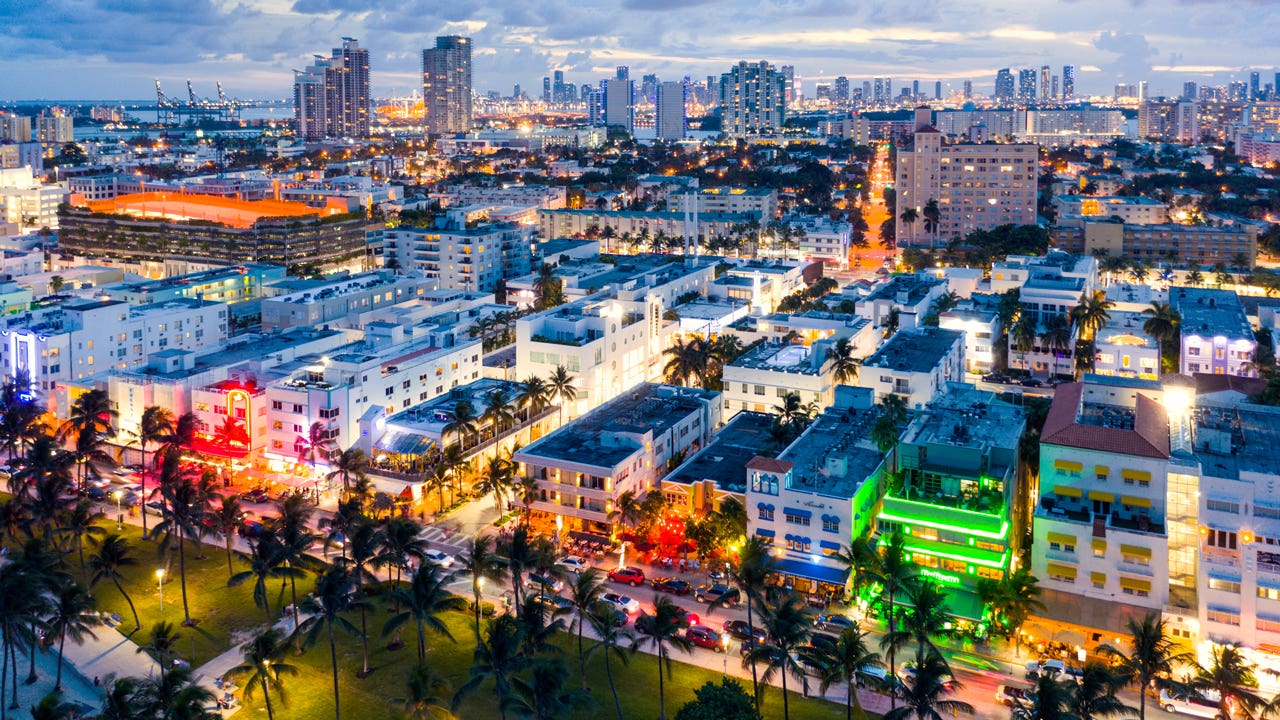The true cost of living in Miami 2023

The Bankrate promise
At Bankrate, we strive to help you make smarter financial decisions. To help readers understand how insurance affects their finances, we have licensed insurance professionals on staff who have spent a combined 47 years in the auto, home and life insurance industries. While we adhere to strict , this post may contain references to products from our partners. Here's an explanation of . Our content is backed by Coverage.com, LLC, a licensed entity (NPN: 19966249). For more information, please see our .
Florida is known for sandy beaches, diverse culture and low taxes, and the palm trees and bright lights of Miami traditionally come to mind when you think of the Sunshine State. But the housing market in Florida has significant financial challenges, so if moving to Miami is on your wishlist, you may want to understand the true cost of living there before packing your bags.
The cost of living in Miami is driven by factors besides housing. Data from Salary.com shows that prices in Miami increased nearly 3% from a year ago, with the biggest price increases occurring in transportation and food, in addition to housing. Overall, Salary.com’s analysis found that the cost of living in Miami is 15.4% higher than the national average.
Despite the high cost of living in Miami, many people continue to move to the area. The 2010 U.S. Census found that Miami’s population was 2,496,435, and in the 2020 Census, the population had grown to 2,701,767. In 2022, Florida saw an influx of more than 444,485 new residents, making it the fastest-growing state in the nation.
Housing costs in Miami
When evaluating the true cost of living in Miami, housing is one of the most important factors. According to RealtyHop’s Housing Affordability Index for October 2023, Miami is the least affordable place to live in the U.S. Miami homeowners average $3,040 per month on mortgage and tax payments — which is a staggering $36,480 per year.
For the first time since 1970, the U.S. Census recorded a population decrease in Miami-Dade County of 1 percent. While many people are moving into the area, 79,535 moved out of Miami into other states or counties within Florida. For most people, housing is their biggest expense and unaffordable rent and home prices are cited as to why residents within the middle-class income spectrum are leaving. Whether you rent or own, here is what you need to know about the cost of housing in Miami.
Average cost for a house
The average home price in Miami has skyrocketed in recent years. This is partly due to the fact that many Americans moved to Florida during the COVID-19 pandemic.
In the 12 months after July 1, 2020, an estimated 220,890 people moved to Florida — the biggest population increase of any state during that time frame. However, that number more than doubled with 444,485 new residents by July 1, 2022. That means, on average, there were 1,218 new Florida residents moving from other states per day.
During the pandemic, Florida was a popular place to move because of the lack of income tax, warm weather year-round and spacious neighborhoods. Due to increased housing demands, the average Florida home price rose from $360,000 in 2019 to $469,562 in Q1 of 2022. As of October 2023, median home prices increased 8 percent to $524,960 with a median price per square footage of $370.
Homeowners insurance
Miami real estate is located in the heart of Florida’s homeowners insurance crisis. Increases in the severity and frequency of flooding and tropical storms combined with inflation, insurance fraud and a rocky economy have caused several companies to stop writing homeowners insurance coverage in Florida. As a result, homeowners have limited options and higher premiums. Coastal cities like Miami are particularly vulnerable to catastrophic losses, and with high replacement costs, some homeowners are forced to secure coverage with Citizens Insurance, Florida’s government-backed insurer of last resort.
Houses are a significant investment, and home insurance can help protect your finances if your property or belongings are damaged by common weather-related risks. When searching for cheap home insurance in Miami, it’s good to remember that cheap is relative. The average cost of Miami home insurance is $3,090 per year, which is more than double the national average of $1,428.
Since even the best home insurance policies usually exclude flood damage, another factor to consider is the cost of flood insurance. If you are unable to secure flood insurance through a private provider in the area, you can purchase a policy through the National Flood Insurance Program (NFIP). The annual average cost of an NFIP policy in Miami-Dade is $965, but this can vary significantly depending on the zipcode, home construction and several other factors.
Average cost for an apartment
Renting is usually cheaper than purchasing a home. But in Miami, renting an apartment is still quite expensive. According to RentCafe, the average cost of rent for an apartment in Miami is $2,438 per month for an 891-square-foot apartment. For perspective, the national cost of rent for an apartment of the same size is $1,702. The most expensive neighborhoods to rent in are the Miami Design District ($3,132), Brickell ($3,094) and Brickell Key ($3,448).
However, the cost of rent in Miami depends on factors like the location, size of the rental and the quality of the unit.
In addition, you may also want to consider the fact that Miami has been experiencing a housing shortage since the mass migration to Florida began over the last few years. This could make it more difficult to find housing, let alone affordable housing. Rent prices have been steadily increasing, with no signs of slowing down.
Renters insurance
Renting an apartment rather than buying a house could be a cheaper option. But in this case, you may still want to consider purchasing a renters insurance policy. In fact, some Miami landlords require tenants to carry renters insurance before signing a lease.
A standard renters insurance policy covers personal property, personal liability and additional living expenses. It’s one of the cheapest types of insurance you can get, and it’s much less expensive than homeowners insurance.
However, renters in Miami also face flood risks. Because renters insurance does not cover flood damage, you may want to speak with your agent about your flood insurance options. While flood insurance can be expensive, renters pay drastically less than homeowners since it will only cover your personal property. According to FEMA, some flood policies for renters start at just $100 per year. Without flood insurance, if a hurricane causes a flood that wipes out everything you own, you would be responsible for replacing your belongings out-of-pocket.
National housing market statistics
Miami isn’t the only metropolitan area experiencing an increased cost of living. Nationwide, home prices are up and more Americans are looking to purchase their own properties. Here are some recent housing market trends from across the country:
- The current national average rate for a 30-year fixed rate refinance mortgage is 8.0%. (Bankrate.com)
- As of October 2023, the national median home price is $425,000, a decrease from September’s median of $430,000. (Realtor.com)
- For September 2023, pending home sales were down 1.8% month-over-month in the West, but increased 4.1% month-over-month in the Midwest. (NAR)
- Existing-sales increased in the Northeast, but decreased in the Midwest, South and West regions in September 2023. (National Association of Realtors)
- In 2022, the rate of homeownership in America was 65.8% compared to 2019 at 64.6%. (NAR)
- The Midwest region of the country has the highest rate of homeownership at 70.3 % as of the first quarter of 2023. (U.S. Census)
- 42% or millennial homebuyers have buyers remorse, citing maintenance and other hidden costs of homeownership being more expensive than anticipated. (Bankrate)
- In 2020, almost two million renters were able to purchase homes in cheaper areas because they no longer had to commute to work. (Census.gov)
- Millennials were responsible for 53% of new primary home mortgages in April 2020. (Fool.com)
- Between July 2020 and June 2021, 35% of home sellers sold their property for more than the asking price. (National Association of Realtors)
The cost of driving in Miami
The cost of driving and car ownership in Miami is increasing alongside the cost of housing. Here is what you need to know about car prices in Miami and how much it costs to insure your vehicle in the state of Florida.
Car prices in 2023
Car prices are up across the country, and that includes in Miami. While average car prices are slowly dropping as of January, finding an affordable vehicle is still very difficult.
According to a report from Kelley Blue Book, the average price of a new car is $48,334 with the average non-luxury vehicles averaging $44,700. Used cars are only a slightly better deal these days. According to Edumds, the average price for a used vehicle during the Q2 in 2023 was $29,472, an increase of 46 percent from the Q2 in 2018.
Even if you can find a great deal on a car, be prepared to sit in traffic. The average one-way commute in Miami takes 28.1 minutes. That’s almost two minutes longer than the U.S. average commute time of 26.4 minutes. Round-trip, you are looking at an average commute of almost one hour in Miami.
Car insurance
In Florida (like in most states), car insurance is a legal requirement. In addition, Florida is a no-fault state, which means drivers are required to carry personal injury protection (PIP).If you get injured in an accident, PIP pays for your medical bills and lost wages, up to coverage limits, regardless of which driver was at fault for the crash.
However, having a comprehensive car insurance policy in Florida could be extremely important. Data shows that there are more accidents in Miami-Dade County than anywhere else in the state of Florida, and over 20% of Florida drivers are uninsured.
Before you purchase a car insurance policy, it’s usually a good idea to shop around and get quotes from a few different companies. Keep in mind that some car insurance companies offer cheaper rates than others, so you should be able to find a policy that fits within your budget, especially if you can take advantage of discounts. The average cost of full coverage car insurance in Miami is $3,483 per year and for minimal coverage the average is $1,168 per year, much higher than the national average.
Public transportation
If you can’t afford to own a car in Miami, you can rely on public transportation to get around and save money. Here are some of the popular public transportation options in Miami:
- Metrorail: The Miami Metrorail includes 25 miles of track that connect the most populated areas of the city. There are 23 stations in areas like Miami International Airport, the Civic Center, downtown Miami and Jackson Memorial Hospital. The Metrorail runs from 5 a.m. to midnight seven days a week. The current standard fare is $2.25 each way or $5.65 for a one day pass. You can pay using an EASY Card, EASY Ticket or the GO Miami-Dade Transit mobile app.
- Metromover: The Metromover is a free transit service that operates seven days a week in downtown Miami and the Brickell area. There are 21 stations, with stops near FTX Arena, Bayside Marketplace and Miami Dade College. Cars arrive every 90 seconds during rush hour and every three minutes during less busy hours.
- Trolleys: The City of Miami operates a free trolley service that runs from 6:30 a.m. — 11 p.m., Monday through Saturday, and 8 a.m. — 8 p.m. on Sunday. There are many stops around the city and you can track the trolley online.
Fun things to do in Miami
Miami is one of the most fun cities in the country and there is something for everyone to enjoy. If you’ve recently moved to Miami and are looking to explore the city, here are some things you might want to check out (and also add to your ‘living in Miami’ budget):
- Beaches: One of the biggest draws of Miami is the beautiful weather that sticks around all year. The beaches of Miami are one of the city’s biggest selling points, whether you want a family-friendly beach, like Key Biscayne, or a more lively spot, like the infamous South Beach.
- Miami Heat games: The Miami Heat is one of the most popular NBA teams in the league. You can check out a game at the FTX center, which is centrally located in downtown Miami.
- Miami Design District: The Miami Design District is a neighborhood that celebrates the city’s arts, architecture and cultural scene. You’ll find shops with items curated by local artists, restaurants from Miami-based chefs and galleries with unique pieces from Miami artists.
- Perez Art Museum Miami: The Perez Art Museum Miami is located in South Beach. Entry currently costs $16 for adults, with discounts for kids and seniors. The 200,000-square foot museum features a rotating collection of art from contemporary artists from the 20th and 21st centuries.
- Vizcaya Museum and Gardens: The Vizcaya Museum and Gardens is located in Coconut Grove, FL. It was built by James Deering in 1914 and is an architectural marvel, complete with 10 acres of gardens. Several movies have been filmed in the museum and gardens.
- Wynwood Walls: Wynwood Walls is also called the Urban Graffiti Art Museum Miami. As the name suggests, this mostly-outdoor museum is dedicated to graffiti art which can be seen on outdoor displays.
- Bayside Marketplace: Bayside Marketplace is one of the biggest shopping and dining centers in Miami, with a variety of popular retail stores and restaurants.
- Little Havana: Little Havana is a neighborhood in Miami that showcases the city’s Cuban history. You’ll find Latin-inspired restaurants, shops and events that celebrate Cuban culture in South Florida.
- Brickell City Center: Brickell City Center is another shopping mall in Miami, with a variety of stores and restaurants.
- Zoo Miami: Zoo Miami is home to many exotic animals, including snakes, crocodiles, native Florida birds, lions, elephants, tigers, rhinoceros and many others. Admission currently costs $22.95 for guests over 13 or $18.95 for guests under 13. Admission is free for kids under 2 and zoo members.
Frequently asked questions
-
-
Yes, Miami is currently one of the most expensive cities to live in and in regard to the housing market, it is the most unaffordable. When looking to move into any part of Florida, there are more factors to consider than just the cost of rent or mortgage payments. Aside from the price and availability of auto, home and flood insurance, you may want to factor in the added risk associated with living in a location so prone to catastrophic loss.
-
The cost of living in Miami is 15.4 percent higher than the national average. While the cost of energy is about 12 percent lower in Miami, housing, food, healthcare and transportation are drastically higher. According to the MIT’s living wage calculator shows that a living wage in Miami-Dade County would need to be $106,367 for two working parents with two children. If that seems on the high end, remember that the bulk of residents moving out of Miami are considered middle income, which is around $61,000 in Florida.
-
The cost of relocation to Miami depends heavily on where you are moving from. Other factors that contribute to relocation costs are:
- How much you are bringing with you — it costs more to move a three-bedroom house vs. a studio apartment
- If you need storage at a facility
- If you hire movers to help pack, load and deliver your furnishings vs. doing it yourself
- If you need a car transport
- If you need to move a pet
- Time of year
- If you need insurance for breakables
-
The average cost of car insurance in Florida is $3,183 per year for full coverage, which breaks down to $265 per month. While that is much higher than the national average, drivers in Miami pay even more at an average of $3,483 per year for full coverage and $290 per month. For drivers that only want minimal coverage, the average cost of a liability-only policy in Miami is $1,168 per year, about $97 per month.
-
Related Articles



